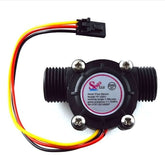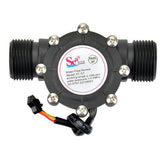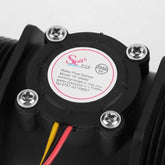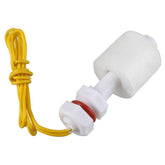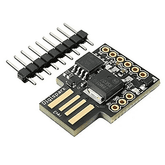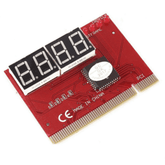What is a Water Sensor?
Summary
Would you like to take an interesting trip into the world of water level sensors?
This blog post discusses the many types of sensors that are available, their benefits, and their wide range of uses.
These sensors play a critical role in protecting water resources and ensuring their wise use, from tending crops with irrigation systems to monitoring the water levels in large dams.
What is a Water Sensor

Water sensors are useful tools for sensing water levels in a variety of settings. There are a variety of sensors available, including ultrasonic sensors, pressure transducers, bubblers, and float sensors, each with a separate function.
Whether you need to monitor water levels in a tank, pond, or other application, smart water detectors provide precise and dependable data to keep things operating smoothly.
Working on Water Level Sensor
The working principle of the water level sensor is that when the sensor is put into a certain depth in the liquid to be calculated, the pressure on the sensor’s front surface is converted into the water level height. In short, a water sensor works by measuring the pressure on its surface when placed in a liquid. This pressure is then used to calculate the water level.

The formula is Ρ=ρ.g.H+Po,
where P is the pressure on the water surface of the sensor
ρ is the density of the water that is to be measured
Po is the atmospheric pressure on the water’s surface
g is the acceleration of gravity
H is the depth at which the sensor drops into the liquid.
The level sensor is a device designed to monitor and calculate liquid levels. When the liquid level is detected, the sensor converts the sensed data into an electrical signal that can be propagated and displayed.
Also learn all about the Rain Sensor technology
Types of water sensors
There are 7 types of water sensor, such as:1. Optical water level sensor
These sensors use infrared LEDs and phototransistors. When the sensor is present in the air, they are optically coupled.
When the sensor head is immersed in the liquid, the infrared light will escape which leads to the output changing. These sensors can detect whether the water is present or absent.
They are not sensitive to ambient light and are not affected by foam when in air and small bubbles when in liquid.
This makes them useful in situations where state changes must be recorded quickly, and in situations where they can operate reliably for long periods without maintenance.

2. Capacitance liquid level sensor
Capacitance level switches have two conductive electrodes they are usually made of metal, in the circuit and the distance between them is very short.
The circuit is complete when the electrode is immersed in the liquid.

3. Tuning fork level sensor
The tuning fork level gauge is a liquid point level switch tool developed based on the tuning fork principle. Every object has its resonant frequency.
The resonant frequency of the body is related to its mass, size, shape, and force.
The working principle of the sensor is to cause its vibration through the resonance of the piezoelectric crystal.

4. Diaphragm liquid level sensor
The diaphragm or pneumatic level sensor depends on the air pressure to push the diaphragm, which engages a micro switch inside the main body of the device.
As the liquid level rises, the internal pressure in the detection tube also increases until the microswitch is activated. As the liquid level drops, the air pressure decreases, and then the switch opens.

5. Float water level sensor
Float level sensor is continuous level sensors featuring a magnetic float that rises and falls as and when the liquid levels change.
The motion of the float generates a magnetic field, which activates a hermetically sealed reed switch placed in the level sensor's stem, causing the switch to open or close.
Many different types of float switches are utilized in commercial and industrial applications involving water, oil, chemicals, and other liquid fluids.
There are multiple options such as vertical mount and side mount options, and the choice of a stem made from either hard plastic or non-magnetic metal such as stainless steel.

6. Ultrasonic liquid level sensor
The ultrasonic level gauge is a type of water level detector that is a digital level gauge controlled by a microprocessor.
In the measurement, the ultrasonic pulse is cast by the sensor (transducer). When the sound wave is reflected by the liquid surface, it is received by the same sensor.
It is converted into an electric signal by a piezoelectric crystal present in the sensor. The time between the transmission and reception of the sound wave is used to estimate the distance to the surface of the liquid.

7. Radar level gauge
It is a type of water level sensor based on the principle of time travel. The radar wave runs at the speed of light, and the running time can be transformed into a level signal by electronic components.
When the probe sends out high-frequency pulses which travel at the speed of light in space.
These pulses meet the surface of the material and then they are reflected and received by the receiver in the meter. After the distance signal is converted into a level signal.

Advantages of Water Sensors
- Easy to install.
- Very little maintenance.
- The automatic water level sensors ensure no overflows or running of dry pumps.
- Is more economic as it uses less water and electricity.
- Compact design.
- Avoids seepage of walls and roofs due to tanks overflowing.
- Low power consumption is perfect for continuous operation.
- Shows incitation of water levels in any type of tank or container.
Applications of Water Level Sensor
Applications of a water level indicator include:
- Home apartments
- Hotels
- Where cooling towers are used
- Commercial complexes
- Factories
- Residential and commercial swimming pools
- Anywhere water levels need to be controlled
- In vehicles as a fuel level indicator
- In huge containers as a liquid level indicator
- Single phase motor
- Single phase submersibles
- Open wells
- Three phase motors
- Bore wells
- Sump Pumps
- Used to start and stop water pumps
- Water level indicator for water tank
- Washing machines
- Dishwashers
- Refrigerators with ice makers and water dispensers
- Hot-water heaters
- Sinks
- Toilets
- Furnaces and boilers
- Fish tanks
The smart technology in water-sensor systems can help alert homeowners of potential leaks and prevent the need for costly and time-consuming repairs.
Water damage is a common and expensive cause of loss. Today, smart home technology is helping consumers manage their risks.
In addition to potentially preventing serious damage, water detectors can also help a homeowner avoid the loss of personal possessions and the strenuous task of disruptive repairs to their home.
Conclusion
In a variety of industries, water level sensors are crucial for effective water management. Their top priorities are sustainability, productivity, and safety.
The content of this page lists many types of sensors along with their uses and advantages. Knowing their practical uses demonstrates their capacity to keep an eye on water usage in swimming areas, industrial processes, and agricultural environments.
Get a water sensor as soon as possible if you want to maximize your water management!
If you appreciate our work don't forget to share this post and leave your opinion in the comment box.
Please do check out other blog posts about Popular electronics
Make sure you check out our wide range of products and collections (we offer some exciting deals!)



